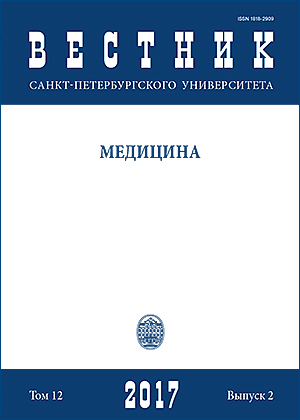CORRECTION OF RENAL FUNCTION BY DESMOPRESSIN AND DICLOFENAC IN INCONTINENT WOMEN WITH NOCTURIA
DOI:
https://doi.org/10.21638/11701/spbu11.2017.205Abstract
The purpose of this study was to evaluate the clinical efficiency of desmopressine and diclofenac in incontinent patients with nocturnal polyuria and polyuria. A total of 277 patients ≥18 ≤ 55 years of age with complaints of urinary incontinence were included. 143 women had stress incontinence, 43 — urge incontinence and 91 — mixed incontinence. The overall prevalence of nocturia was 34.7 ± 2.9% (96 women).The frequency of poliuriya was 7 ± 2.1 % in stress incontinence, 11.6 ± 4.9 % in urge incontinence and 9.9 ± 3.1 % in mixed incontinence (p > 0.05). The frequency of nocturnal polyuria was 17.5 ± 3.2% in stress incontinence, 27.9 ± 6.8% in urge incontinence and 25.3 ± 4.6 % mixed incontinence (p > 0.05). Patients were randomized to receive either desmopressin or diclofenac in a double — blind fashion. The statistically significant recovery of renal function occurred in 8 incontinent women with polyuria and 19 with nocturnal polyuria who received diclofenac and in 12 incontinent women with polyuria and 18 with nocturnal polyuria who received desmopressin (Minirin). Refs 5. Figs 12. Table 1.
Keywords:
renal osmoregulatoin function, incontinence, sodium excretion, desmopressin, diclofenac
Downloads
References
References
Double-Blind, Placebo Controlled, Parallel Group Study. The Journal of urology, 2013, vol. 190 (3), pp. 958–964.
Russian)
Downloads
Published
How to Cite
Issue
Section
License
Articles of "Vestnik of Saint Petersburg University. Medicine" are open access distributed under the terms of the License Agreement with Saint Petersburg State University, which permits to the authors unrestricted distribution and self-archiving free of charge.




